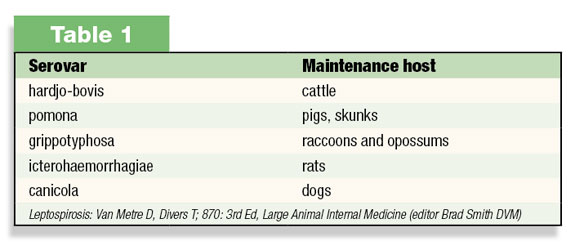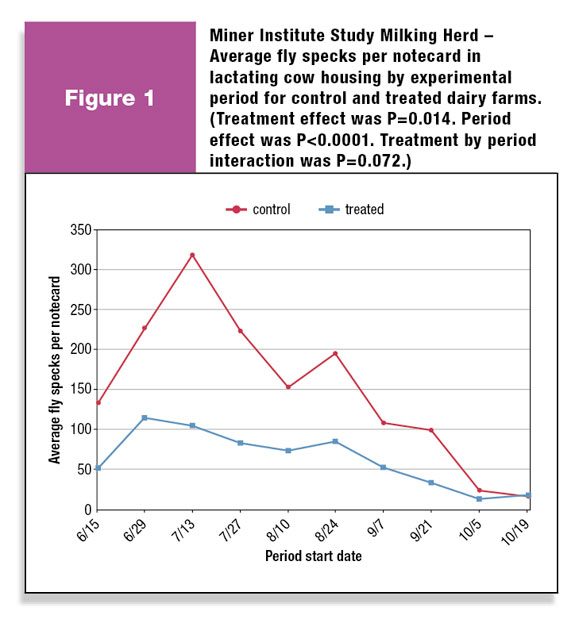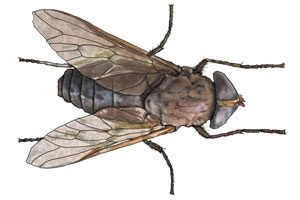Within any confined dairy or cattle operation, ectoparasites such as house, stable, face and horn flies pose a significant threat to overall cow health, comfort and performance, and the economic losses to the operator can be severe if not proactively and aggressively addressed. The primary goals in reducing fly populations, specifically on dairy farms, are to increase cow comfort (thus maximizing milk production) and reduce the potential spread of disease pathogens.
Dairy operators can manage fly infestations by developing and implementing a comprehensive integrated pest management (IPM) program, a pest-control strategy that uses an array of complementary methods: cultural practices, biological controls, exclusion and pesticides to manage fly problems.
These principles need to be an ongoing practice to achieve satisfactory control. A practical example of IPM would be good sanitation, which includes proper manure and spilled feed management.
Additionally, the use of traps, bait stations and parasitic wasps can be effective. Other areas to consider in a program would be vegetation management around animal areas to reduce fly resting sites and the inclusion of a feed-through larvicide.
Adult house and stable flies can breed in manure and other decaying organic matter, including silage. Good sanitation practices, such as cleaning up spilled feed and preventing manure buildup around barns and fences or under feedbunks, will eliminate breeding sites for these flies.
Adult flies can also migrate from other areas. In these situations, supplemental fly control measures may be needed in and around barns, calf pens and dry lots. On-animal and premise insecticide applications and/or the use of traps and baits may be necessary to control these migrating adult flies.
Fly identification and impact
• House fly: House flies are nonmetallic, dull grayish flies approximately six to seven millimeters in length with four distinct stripes on their thorax. The abdomen of the house fly is usually a pale color with yellowish sides and underside.
Female house flies lay one-millimeter-long, slightly curved, whitish eggs normally deposited in batches of approximately 150 eggs in animal manure, wet organic matter, spilled feed, compost piles, decaying fruit and various other potential larval development areas.
The larvae of the house fly hatch within 24 hours, are white in color and feed on manure or other decaying organic matter. The larvae will grow and eventually migrate away from the food source to drier areas to pupate. Pupae are dark brown.
The pupal stage will last anywhere from three to 10 days depending on temperature. Adults emerge from the puparium and begin feeding within 24 hours, with sponging-type mouthparts, and the life cycle is repeated.
• Stable fly: Stable flies are blood feeders that, in high numbers, can reduce cow comfort and cause production losses. The economic injury level for dairy cattle is when two to five stable flies are seen on the front leg.
Losses due to stable flies can mount with increasing fly populations. These flies irritate cattle during resting, feeding and milking, thereby reducing milk production by 15 to 30 percent.
As few as four stable flies per cow can reduce production by 3 percent per month. Not only do these flies cause reduction in cow comfort and production, but they can also transmit pathogens that cause mastitis.
Females lay hundreds of eggs in manure, wet hay and other decaying organic matter.
The stable fly is close in size to the house fly and has similar stripes on its thorax; however, stable flies have a distinct “checkerboard” pattern on their abdomens.
In addition to this, they have distinct piercing-type mouthparts used to penetrate the skin of their hosts to obtain blood meals. Stable fly eggs are about one millimeter in length and are usually laid in masses of up to 50 eggs. Eggs hatch in one to three days.
Larvae prefer decaying vegetation such as grass clippings, hay, spilled feed and silage. A mix with manure makes the breeding sites even more attractive. Like house fly larvae, stable fly larvae will migrate to drier areas to pupate.
Depending on the temperature, new adults will emerge for these pupae in six to 26 days. The entire life cycle takes three to four weeks.
William H. Miner
Agricultural Institute study
• Methodology: In mid-2008, Central Life Sciences, whose founders invented biorational pest control more than 30 years ago, commissioned a study with the William H. Miner Agricultural Research Institute at 12 dairy farms located in northern Vermont.
The objective of the study was to determine the effectiveness of larvicide on fly populations on dairy farms when included in feeds as compared to the use of conventional fly control methods.
The study was established using a randomized block design utilizing 12 dairy farms, and each was assigned to six blocks by herd size, geographic location and lactating herd housing.
Parameters such as landscaping around barns, barn floor plan, manure management systems and feedbunk placement were also considered in an effort to reduce within-block variations.
The study was conducted over 108 days with fly populations sampled by block once every 14 days. Since one dairy did not keep calves and two others only provided temporary housing, after the completion of the study, the dairies were reblocked according to calf housing for analysis of fly populations.

On treated dairy farms, larvicide was added to all purchased feeds at the labeled rate of 0.10 mg diflubenzuron/kg BW/day.
Dairy farms were asked to discontinue all other fly management practices and comply with label recommendations.
Dairy farms in the control group were allowed to continue their regular fly management practices, with the exception of the use of any feed-through larvicide.
• Fly population monitoring: Fly populations were monitored using fly speck cards, a tool which evaluates the number of fecal and vomit spots on the face of each card. Each card was removed after two weeks of exposure and replaced with a new card.
Two other methods were used to monitor fly populations. These other methods were fly counts on calves made at random and walking a designated path with a cardboard tube with adhesive.
All fly counts were used to evaluate the efficacy of the larvicide. Monitoring tools were used in the milking herd and calf barns. At the close of the study, fly counts were tabulated and the data was subjected to statistical analysis.
In addition to fly counts, bulk tank information was collected every two weeks. Information collected included milk fat and protein percent, somatic cell count and pounds of milk per animal.

Results
The tabulated data showed a significant reduction in house flies in the treated milking herd.
The results in the calving areas did not show a clear reduction until later in the season.
It is suspected that since the calves were not on treated feeds early in life, the flies continued to develop uninhibited.
It was not until later, when the calves were on solid treated feeds, that the fly population begin to diminish.
Bulk tank information showed evidence of increases in milk fat and protein and a reduction in somatic cell count.
However, a larger sample size of dairies needs to be investigated to reach a firmer conclusion about the impact of reduced fly populations on these parameters.
Conclusion
Flies infesting dairies can be a significant problem relating to cow comfort and economic losses. There are viable solutions available to manage these important pests.
A multi-pronged or integrated approach which includes sanitation, vegetation management, biological controls, traps and appropriate pesticides can reduce fly populations, thereby creating comfort for all and increased profits. PD
References omitted due to space but are available upon request to editor@progressivedairy.com .
Doug VanGundy
Director of Specialty Product Development
Central Life Sciences
DVangundy@central.com






